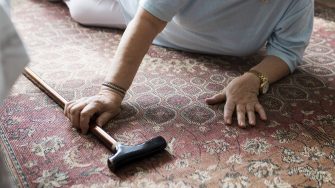How Videos Of Falls Can Guide The Prevention Of Falls In Older People
Dr Kim van Schooten has co-led efforts to capture accurate falls data and recommend strategies to prevent falls in older people living in long-term care settings (LTC).
Dr Kim van Schooten has co-led efforts to capture accurate falls data and recommend strategies to prevent falls in older people living in long-term care settings (LTC).

The ability to safely rise from sitting to standing, known as a sit-to-stand transfer, is essential for most activities of daily living. Although getting up from a desk or standing up from a dinner table may appear straightforward – about 50% of older people in LTC encounter challenges in rising safely and independently, with approximately 10% of falls occurring while attempting to rise from sitting.
Dr Kim van Schooten notes, “While previous studies had highlighted the balance demands of sit-to-stand transfers, there was limited knowledge on how and when falls occur.”
The study aimed to characterise the circumstances of falls during sit-to-stand transfers by analysing videos of real-life falls in LTC. The authors hypothesized that falls would happen with similar frequency during the rising and stabilization phases of transferring, with differences in the direction of the fall, balance recovery responses, and the risk for injury during rising versus stabilization.
Over a 13-year period (2007-2020), 2852 videos of falls by 774 LTC residents were collected. Of these videos, 183 residents were captured falling during sit-to-stand transfers. Their average age was 84 years, with 81% dependent in activity of daily living, and 84% having moderate to severe cognitive impairment. Common disease diagnoses included hypertension (60%) and Alzheimer’s disease (32%).
Falls during sit-to-stand transfers occurred twice as often during the rising phase compared to stabilization. Falls during rising tended to be backward, while during stabilization, they were almost twice as likely to be sideways. Grasping for balance was more common during rising, while stepping was more common during stabilisation. Injuries were more likely during stabilisation compared to during rising.
Dr Kim van Schooten highlights, “This study pinpoints when people are at the highest risk of falling during sit-to-stand transfers. In nearly two-thirds of cases, the fall started during the rising phase and was directed backwards, emphasizing the need to address strength, power, and flexibility with exercise. We also see a role for training reactive stepping, as it often serves as a last resort to prevent the fall. Falls during rising often involved a backward movement of the seating surface, underscoring the need for improved chair design and automatic braking systems.”
“Being able to capture and analyse video evidence of falling has provided important and objective data on falls in LTC homes. With this information, we can suggest evidence-informed strategies, programs, and initiatives to enhance residents’ safety by preventing serious and life-threatening falls.”
Read the full publication here.